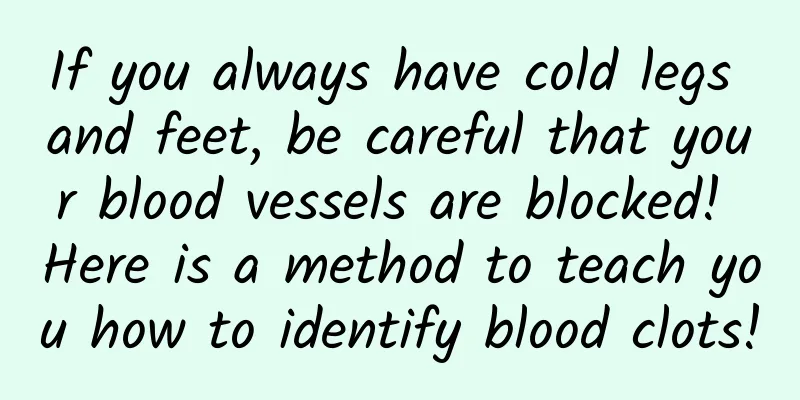If you always have cold legs and feet, be careful that your blood vessels are blocked! Here is a method to teach you how to identify blood clots!

|
In winter, your feet feel like ice cubes. Many people have this experience. But some cold feet and legs may be caused by problems with blood vessels. Cold legs and feet may be caused by blood vessels being blocked The First Affiliated Hospital of Zhejiang University School of Medicine shared a case on its official account on December 6. Mr. Wu (pseudonym), 36, has had cold legs and feet since the beginning of winter. No matter how hard he tried to warm them up, they wouldn't get warm. He gradually developed pain symptoms, especially in his right foot, which hurt a lot when he walked and he walked with a limp. After a series of examinations at the hospital, it turned out that the blood vessels were blocked! Zhu Qianqian, deputy chief physician of the Department of Vascular Surgery at the First Affiliated Hospital of Zhejiang University School of Medicine, said that although Mr. Wu was young, he had already developed arteriosclerosis. The rupture of arteriosclerotic plaques led to thrombosis, which caused the artery in his right foot to be blocked tightly. His cold feet and intermittent claudication symptoms were caused by the blood vessels being blocked by thrombosis, which prevented blood from flowing to his right leg and right foot. His right foot was ischemic, resulting in cold and painful symptoms. Copyright images in the gallery. Reprinting and using them may lead to copyright disputes. These symptoms may be the blood vessels "calling for help" People with cold legs and feet should pay attention! Don't think it's just because of the weather, it may be because the blood vessels are blocked. If not treated in time, amputation may be required in severe cases. There are two main types of blockage of lower limb blood vessels: lower limb arteriosclerosis obliterans and lower limb deep vein thrombosis. Jin Yongjian, chief physician of the Third Department of Neurosurgery at the Air Force General Hospital, said that blood vessel blockage is not something that happens overnight, but is accumulated gradually over time. To prevent thrombosis, we must pay attention to these signals sent by the body. 1 Numbness in legs When there is a blood clot in the human body, the limbs will feel numb and painful due to insufficient blood supply. Therefore, if you suddenly feel leg pain, pressure or numbness in the lower limbs in your life, you must be alert. 2 Walking with a limp If the blockage of blood vessels worsens, intermittent claudication will occur. After walking a few hundred meters, your legs will feel sore and you need to rest for a while to relieve it. Blood clots can cause insufficient blood supply, leading to muscle soreness. If the blockage of the lower limb arteries is ignored and the disease progresses further, it may lead to severe ischemia of the lower limbs, a decrease in skin temperature, weakening or disappearance of the pulsation of the dorsalis pedis and posterior tibial arteries, and lower limb pain when not walking. Further development may lead to limb ulceration, inability to heal wounds, and even tissue necrosis. 3 Legs become thicker When blood clots form in the veins, blood cannot flow back to the heart. Pressure causes fluid to spread into the leg tissues. The easiest way to identify it is sudden swelling of one leg, usually below the knee. If you feel swelling in your calf but cannot confirm it by visual inspection, you can use a tape measure to compare. A method to teach you how to identify blood clots! Tong Mingxiao, head nurse of the Nursing Department of Beijing Jishuitan Hospital, said in an interview that a good way to check for deep vein thrombosis at home is to measure the circumference of the leg. The measurement method is: measure 15 cm above the patella and 10 cm below the patella, and compare the two legs. If one leg is more than 1 cm swollen than the other leg, it means there is a problem. If both legs are swollen, today's measurement is 23 cm, and tomorrow's measurement is 25 cm for both legs. In addition to drinking a lot of water, urinating less or other symptoms, you must also consider the risk of deep vein thrombosis in the lower limbs and seek medical attention as soon as possible. Drinking 5 glasses of water can prevent blood clots 1 First glass of water: After waking up Morning is the time when the body's physiological blood pressure rises, platelet activity increases, and blood viscosity increases. Drinking water after getting up can help reduce blood viscosity and thus reduce the risk of thrombosis. Warm boiled water is the best choice. 2 2nd glass of water: before morning exercise Many people are used to drinking water after morning exercise. You should drink a small amount of water before morning exercise to reduce the risk of dehydration and blood viscosity caused by exercise, and help prevent blood clots. Don't drink water too fast, but drink small amounts and multiple times. 3 3rd glass of water: half an hour after meal Do not drink water immediately after a meal, otherwise it will dilute the saliva and gastric juice, affecting digestion and absorption. Drinking water half an hour after a meal, about 200 ml, will help alleviate the increase in blood viscosity after a meal. But drink in small sips, otherwise frequent and large amounts of water will easily cause heartburn. 4 4. Glass of water: before leaving get off work Office workers often neglect to drink water due to their busy schedule, which provides an opportunity for blood clots to invade. It is recommended that office workers develop the habit of drinking a few sips of water before leaving get off work. A paper cup is enough. Don't drink too much, otherwise you will easily feel the urge to urinate on the way home from get off work. 5 5. Glass of water: before going to bed Take a sip of water before going to bed. When people are asleep, the body loses water, causing the blood viscosity to increase. Drinking some water before going to bed can alleviate this phenomenon and reduce the risk of cerebral thrombosis. In addition, it is best for the elderly to always have a glass of water by the bed before going to bed and drink a few sips when they feel thirsty. References [1] 2023-12-06 Zhejiang University First Hospital "Cold legs and feet are actually your blood vessels crying for help! Many people have these habits" [2] 2019-10-08 Health Times: Four Signals of Thrombosis [3] 2016-11-08 Health Times "Measure your leg circumference to detect deep vein thrombosis early" [4] 2018-12-14 Health Times: "Five glasses of water can prevent blood clots" Planning and production Source: Health Times Reviewer: Tang Qin, Director and Researcher of the Science Popularization Department of the Chinese Medical Association Editor: Wang Mengru |
>>: Green tongue, orange skin, black poop...maybe they're all caused by what you eat!
Recommend
Dong Changzheng: Changes in users make Toyota "unorthodox"
From June 5th to 6th, the 2018 (9th) Global Aut...
Taste the Farmland during the Solar Terms | The first chicken for late autumn tonic may come from this family
In autumn, many people choose to eat chicken to n...
How come there are still typhoons in November? Experts explain super typhoon "Connie"
Who would have thought that a super typhoon would...
One picture to understand | Beijing releases cancer monitoring data, who is the "number one killer"?
Editor/Ding Lin Art Editor/Lancheng New Media Edi...
Is the small belly to protect the uterus and ovaries? Doctors warn: Excessive abdominal fat is very harmful!
gossip “A woman’s small belly is to protect her u...
Which part-time job platform is best? Which platform is best for part-time work with daily pay?
Which part-time job platform is best? Which platf...
To Wang Xuehong: The best apology to shareholders is to sell HTC
Recently, HTC CEO Wang Xuehong bowed and apologiz...
WeChat Mini Programs, what kind of social ambitions does Zhang Xiaolong have?
A photo Zhang Xiaolong posted on his Moments yest...
Shocking! The space station's robotic arm moves in a "movie-level" way, unlocking a new perspective on the Earth from space
【Today's Science】 The space station's rob...
Top 5 popular marketing models in 2021
There is less than a month left in 2021. The two ...
Why do others keep making money by selling home appliances?
Don't talk about reason, just tell the facts....
The designer of the first iPhone pointed out this big flaw of the iPhone
As Apple's fall conference draws closer, leak...
Volkswagen Group's profit fell by nearly 40% in 2020, and its sales fell back to ten years ago
2020 was a difficult year for Volkswagen Group. G...
Jia Yueting is the only FF founder left, and FF is close to running out of funds
According to US media reports, Faraday Future'...
Home appliance manufacturers will have to fight four tough battles in the future
Life goes on, time goes on, and the battle of hom...









